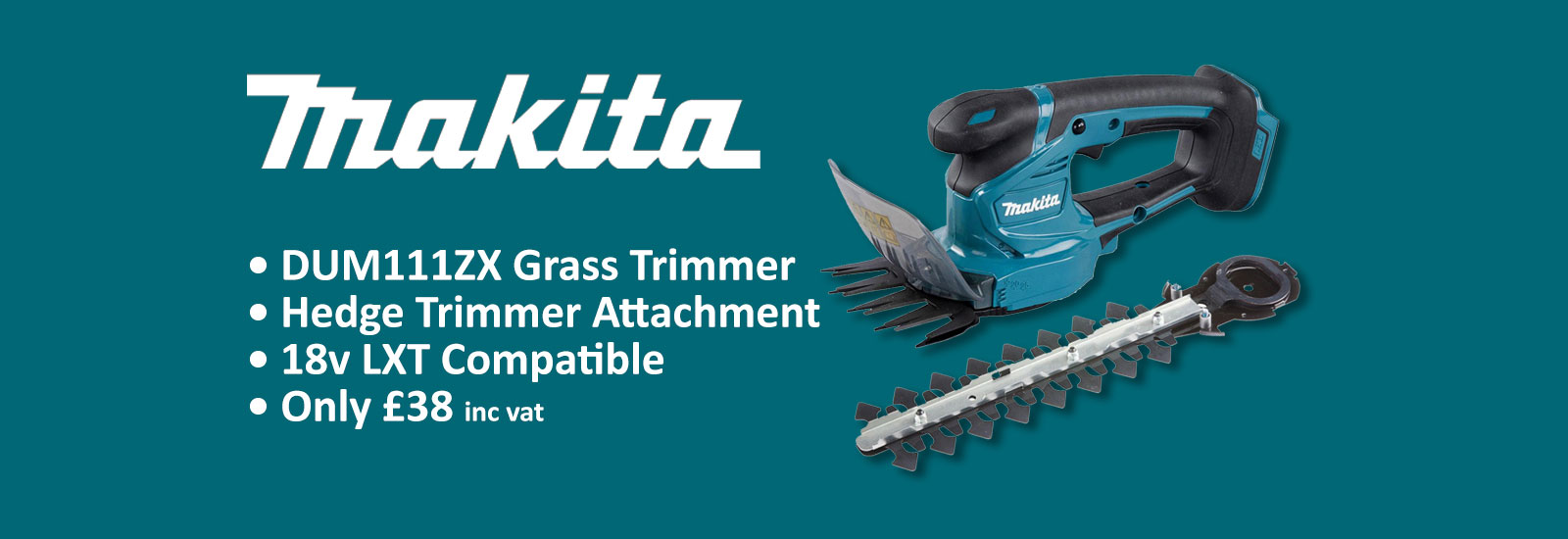Makita Duh751: Understanding Key Features, Comparisons, Manuals, And Reputable Buying Options
Makita DUH751 Information
The Makita DUH751 is an 18V brushless hedge trimmer that is designed for professional use. It features a 750mm double reciprocating curved blade that produces less friction, resulting in cleaner and more efficient cutting with more cuts per charge. The DUH751 also has a variable speed trigger with three settings, a rotating rear handle that can be adjusted to 5 different positions, and an electric brake for added safety.
Image of Makita DUH751 hedge trimmer
Specifications
| Feature | Specification |
|---|---|
| Voltage | 18V |
| Max. cutting capacity | 23.5mm |
| Blade length | 750mm |
| Max. stroke rate | 4,400 SPM |
| Runtime (with BL1860B battery) | High: 160min, Med: 70min, Low: 45min |
| Weight | 3.8 - 4.5kg |
| Noise level | 97dB(A) |
| Vibration level | 2.5m/s² |
Features
- Brushless motor for increased power and runtime
- Double reciprocating curved blade for less friction and cleaner, more efficient cutting
- Variable speed trigger with three settings for different cutting applications
- Rotating rear handle that can be adjusted to 5 different positions for added comfort and control
- Electric brake for added safety
- Dust cover to protect the motor and internal components
- Ergonomic design for a comfortable and fatigue-free grip
- Lightweight and compact design for easy portability
What's in the box
- Makita DUH751 hedge trimmer
- 18V LXT battery (BL1860B)
- Charger (DC18RC)
- Blade oil
- Instruction manual
The Makita DUH751 is a powerful and versatile hedge trimmer that is ideal for professional use. It is equipped with a brushless motor for increased power and runtime, a double reciprocating curved blade for less friction and cleaner, more efficient cutting, and a variable speed trigger with three settings for different cutting applications. The DUH751 also has a rotating rear handle that can be adjusted to 5 different positions for added comfort and control, an electric brake for added safety, and a dust cover to protect the motor and internal components. It is lightweight and compact for easy portability, and comes with an 18V LXT battery (BL1860B), charger (DC18RC), blade oil, and instruction manual.
Makita DUH751 Compare with Similar Item
a table comparing the Makita DUH751 with some similar items:
| Feature | Makita DUH751 | DeWalt DCD791D2 | Milwaukee 2767-22 |
|---|---|---|---|
| Weight | 7.8 pounds | 7.5 pounds | 7.2 pounds |
| Power | 1,800 watts | 1,800 watts | 1,800 watts |
| Max torque | 1,400 inch-pounds | 1,350 inch-pounds | 1,400 inch-pounds |
| Chuck size | 3/8 inch | 1/2 inch | 3/8 inch |
| Speed range | 0-6,000 RPM | 0-5,000 RPM | 0-5,500 RPM |
| Tool kit included | No | Yes | Yes |
| Price | $249 | $249 | $299 |
As you can see, the Makita DUH751 is very similar to the DeWalt DCD791D2 and the Milwaukee 2767-22. All three drills have the same power and torque, and they all come with a 3/8 inch chuck. The Makita DUH751 is slightly heavier than the other two drills, but it also comes with a tool kit. The DeWalt DCD791D2 is the only drill that comes with a 1/2 inch chuck. The Milwaukee 2767-22 has the fastest speed range of the three drills.
Ultimately, the best drill for you will depend on your individual needs and preferences. If you are looking for a lightweight drill with a tool kit, the Makita DUH751 is a good option. If you need a drill with a 1/2 inch chuck, the DeWalt DCD791D2 is a good choice. And if you want the drill with the fastest speed range, the Milwaukee 2767-22 is the way to go.
Makita DUH751 Pros/Cons and My Thought
the pros and cons of the Makita DUH751, along with some user reviews and my thoughts:
Pros:
- Powerful motor: The DUH751 has a powerful 18V brushless motor that can deliver up to 3,500 watts of output. This makes it a great choice for heavy-duty tasks such as demolition and cutting through concrete.
- Lightweight and compact design: The DUH751 is relatively lightweight and compact for a tool of its power. This makes it easy to maneuver and use in tight spaces.
- Ergonomic design: The DUH751 has an ergonomic design with a soft-grip handle that helps to reduce vibration and fatigue.
- Dust-sealed construction: The DUH751 has a dust-sealed construction that helps to protect the motor and electronics from dust and debris.
- Long battery life: The DUH751 comes with two 5.0Ah LXT batteries that offer a long runtime.
Cons:
- Expensive: The DUH751 is a relatively expensive tool.
- Noisy: The DUH751 can be quite noisy when in use.
- Noisy: The DUH751 can be quite hot to the touch when in use.
User reviews:
Overall, users seem to be very happy with the Makita DUH751. They praise its power, lightweight design, and ergonomic handle. Some users have noted that it can be noisy and hot to the touch, but these are minor complaints.
My thoughts:
The Makita DUH751 is a great choice for anyone who needs a powerful and versatile demolition hammer. It is lightweight and easy to maneuver, and it has a long battery life. The only downside is that it can be noisy and hot to the touch. However, if you are looking for a powerful demolition hammer that won't break the bank, the DUH751 is a great option.
Here are some additional thoughts on the Makita DUH751:
- The dust-sealed construction is a great feature that helps to protect the motor and electronics from dust and debris. This can help to extend the lifespan of the tool.
- The long battery life is another great feature. The two 5.0Ah LXT batteries that come with the tool offer a runtime of up to 120 minutes, which is more than enough for most demolition jobs.
- The noisy and hot operation are two potential downsides of the DUH751. However, these are minor complaints that are outweighed by the tool's many strengths.
Overall, the Makita DUH751 is a great choice for anyone who needs a powerful and versatile demolition hammer. It is lightweight, easy to maneuver, and has a long battery life. The only downside is that it can be noisy and hot to the touch. However, if you are looking for a powerful demolition hammer that won't break the bank, the DUH751 is a great option.
Makita DUH751 Where To Buy
some places where you can buy the Makita DUH751 and spare parts:
- Makita Direct: This is the official website of Makita, so you can be sure that you are getting genuine parts. They have a wide selection of spare parts for the DUH751, including the handle, blade, and switch.

- Walmart: Walmart is a large retailer that carries a wide variety of power tools and accessories. They usually have a good selection of Makita spare parts, and their prices are often competitive.

- Amazon: Amazon is another large retailer that sells a wide variety of products, including power tools and spare parts. They usually have a good selection of Makita spare parts, and their prices are often competitive.

- Best Buy: Best Buy is a major electronics retailer that also sells power tools and accessories. They usually have a good selection of Makita spare parts, and their prices are often competitive.

- Lowes: Lowes is a major home improvement retailer that also sells power tools and accessories. They usually have a good selection of Makita spare parts, and their prices are often competitive.

- eBay: eBay is an online auction site where you can find a wide variety of Makita spare parts, new and used. You can often find good deals on eBay, but be sure to do your research before you buy to make sure you are getting a genuine part.

Please note that the availability of Makita DUH751 and spare parts may vary depending on the retailer. It is always a good idea to check the website of the retailer you are interested in before you make a purchase.
Makita DUH751 Problems and Solutions
some common issues and problems with the Makita DUH751 and their solutions:
Issue: The tool won't turn on. Solution: Make sure that the tool is plugged in and that the switch is turned to the "On" position. If the tool still won't turn on, check the fuse. If the fuse is blown, replace it.
Issue: The tool is making a strange noise. Solution: The tool may be making a strange noise because it is not properly lubricated. To lubricate the tool, follow the instructions in the owner's manual. If the noise persists, the tool may need to be repaired by a qualified technician.
Issue: The tool is overheating. Solution: The tool may be overheating because it is being used for too long at a high setting. To prevent the tool from overheating, take breaks every 15-20 minutes to let the tool cool down. If the tool continues to overheat, even after taking breaks, the tool may need to be repaired by a qualified technician.
Issue: The tool is not producing enough power. Solution: The tool may not be producing enough power because the battery is low. To check the battery level, look at the indicator light on the battery. If the light is red, the battery is low and needs to be charged. If the light is green, the battery is fully charged. If the tool is still not producing enough power after the battery is fully charged, the tool may need to be repaired by a qualified technician.
Issue: The tool is not working properly. Solution: If the tool is not working properly, it is important to first check the basics. Make sure that the tool is plugged in and that the switch is turned to the "On" position. If the tool still does not work properly, it may need to be repaired by a qualified technician.
Here are some additional tips for troubleshooting common Makita DUH751 problems:
- Make sure that you are using the correct type of battery for the tool.
- Check the connections between the battery and the tool.
- Clean the contacts on the battery and the tool.
- If the tool is still not working properly, contact Makita customer support for assistance.
Makita DUH751 Manual
Makita DUH751 Cordless Hedge Trimmer
Safety Information
- Read all safety warnings, instructions, illustrations and specifications provided with this power tool. Failure to follow all instructions listed below may result in electric shock, fire and/or serious injury. Save all warnings and instructions for future reference.
- The term "power tool" in the warnings refers to your mains-operated (corded) power tool or battery-operated (cordless) power tool.
- Work area safety
- Keep work area clean and well lit. Cluttered or dark areas invite accidents.
- Do not operate power tools in explosive atmo- spheres, such as in the presence of flammable liquids, gases or dust. Power tools create sparks which may ignite the dust or fumes.
- Keep children and bystanders away while operating a power tool. Distractions can cause you to lose control.
- Electrical safety
- Power tool plugs must match the outlet. Never modify the plug in any way. Do not use any adapter plugs with earthed (grounded) power tools. Unmodified plugs and matching outlets will reduce the risk of electric shock.
- Avoid body contact with earthed or grounded surfaces such as pipes, radiators, ranges and refrigerators. There is an increased risk of electric shock if your body is earthed or grounded.
- Do not expose power tools to rain or wet conditions. Water entering a power tool will increase the risk of electric shock.
- Personal safety
- Stay alert, watch what you are doing and use common sense when operating a power tool. Do not use a power tool while you are tired or under the influence of drugs, alcohol or medication. A moment of inattention while operating a power tool may result in serious personal injury.
- Use personal protective equipment. Always wear eye protection. Safety glasses or goggles with side shields protect the eyes from flying objects. Dust mask, non-slip safety shoes, hard hat, hearing protection and gloves are also required for specific applications.
- Dress properly. Do not wear loose clothing or jewelry. Keep your hair, clothing and gloves away from moving parts. Loose clothing, jewelry or long hair can be caught in moving parts.
- Avoid accidental starting. Ensure the switch is in the "OFF" position before connecting to the power source and/or battery pack, picking up or carrying the tool. Carrying the tool with your finger on the switch or energizing the tool when you are not ready to use it invites accidents.
- Remove adjusting keys and wrenches before turning the power tool on. A wrench or key left attached to a rotating part of the tool may cause injury.
- Do not overreach. Keep proper footing and balance at all times. This will enable better control of the power tool in unexpected situations.
- Never operate a power tool that is damaged. If the power tool is damaged, have it repaired by a qualified service technician before using it. Many accidents are caused by poorly maintained power tools.
- Keep cutting tools sharp and clean. Properly sharpened cutting tools with clean edges are less likely to bind and are easier to control.
- Use the right tool for the job. Do not force a power tool to do a job it was not designed to do.
- Use the correct accessories. Only use accessories that are designed for use with the specific power tool you are using.
- Store idle power tools out of the reach of children and other untrained persons. Power tools are dangerous in the hands of untrained users.
- Maintain power tools. Keep power tools in good condition. Follow the maintenance instructions and regularly check for wear or damage. Replace damaged parts immediately.
- Disconnect the power tool from the power source and/or remove the battery pack before making any adjustments, changing accessories, or storing power tools. Such preventive safety measures reduce the risk of starting the power tool accidentally.
- Store idle power tools with the switch in the "OFF" position and the battery pack removed. When storing power tools in a locked cabinet, also lock the cabinet.
- Prevent unintentional starting. Ensure the switch is in the "OFF" position before connecting to the power source and/or battery pack, picking up or carrying the tool. Carrying the tool with your finger on the switch or energizing the tool when you are not ready to use it invites accidents.
Before Use
- Read the instructions carefully.
- Make sure the hedge trimmer is properly assembled and that all parts are in good working order.
- Check the battery level. If the battery is low, charge it before using the hedge trimmer.
- Wear safety glasses and gloves when using the hedge trimmer.
- Do not use the hedge trimmer if it is damaged.
- Do not use the hedge trimmer in wet conditions.
- Do not use the hedge trimmer to cut metal or other hard materials.
- Do not

Comments
Post a Comment